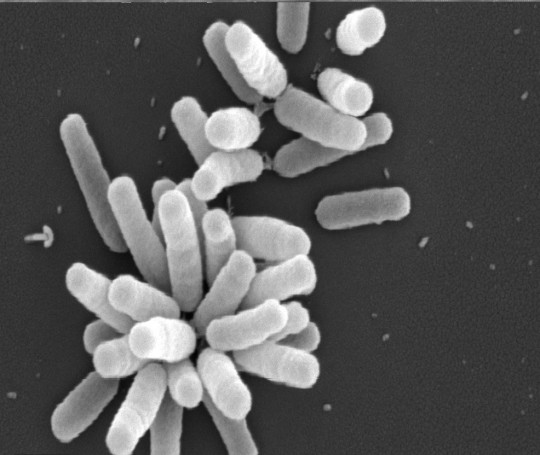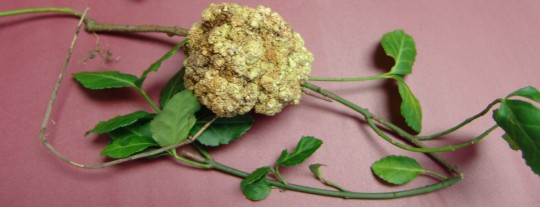Bacterial plasmids — the freeloading and the heavy-lifters — balance the high price of disease
Bacterial plasmids — the freeloading and the heavy-lifters — balance the high price of disease
BLOOMINGTON, Ind. — Studying self-replicating genetic units, called plasmids, found in one of the world’s widest-ranging pathogenic soil bacteria — the crown-gall-disease-causing microorganism Agrobacterium tumefaciens— Indiana University biologists are showing how freeloading, mutant derivatives of these plasmids benefit while the virulent, disease-causing plasmids do the heavy-lifting of initiating infection in plant hosts. The research confirms that the ability of bacteria to cause disease comes at a significant cost that is only counterbalanced by the benefits they experience from infected host organisms.
 A group of crown-gall-disease-causing Agrobacterium tumefaciens cells as imaged by scanning electron micrograph at Indiana University./ Image by Jing Xu, IU Biology
A group of crown-gall-disease-causing Agrobacterium tumefaciens cells as imaged by scanning electron micrograph at Indiana University./ Image by Jing Xu, IU Biology
A. tumefaciens is widely studied for its remarkable biology not only because it causes disease in over 140 genera of broadleaf plants, including fruit trees, grapes, roses and walnut trees, but also because it is considered one of the most important tools for plant biotechnology: It is the only organism known to routinely engage in inter-kingdom lateral gene transfer.A. tumefaciens infects host plants by transferring a portion of its own DNA into plant cells, and this integrated bacterial DNA is expressed in the plant cells, leading diseased plants to develop tumors and produce resources that benefit the pathogen.
“We’ve identified two types of costs the plant pathogen A. tumefaciens pays for traits conferred by genes carried on plasmids,” said lead author Thomas G. Platt, a postdoctoral researcher in the IU Bloomington College of Arts and Sciences’ Department of Biology. “There is a relatively low cost of maintaining the tumor-inducing virulence plasmid, but there is also a dramatically large cost of expressing the genes that are required to infect plants.”
Plants with crown gall disease can also benefit a second type of plasmid that can be found in A. tumefaciens: Nonpathogenic plasmids that lack the genes required to infect plants, yet are still able to benefit from the breakdown of nutrient resources released by infected plant tissue.
 A tumor induced by Agrobacterium tumefaciens in a common landscaping plant, Euonymus, that was identified in Bloomington, Ind./ Photo by Elise Morton, IU Biology
A tumor induced by Agrobacterium tumefaciens in a common landscaping plant, Euonymus, that was identified in Bloomington, Ind./ Photo by Elise Morton, IU Biology
“These nonvirulent strains are able to freeload on public goods produced by host plants infected by their disease-causing relatives, while themselves avoiding the burdens associated with A. tumefaciens’ virulence plasmid,” Platt explained. “And our results suggest that at least one source of the selective pressure favoring the spread of these avirulent mutants stems from those high costs associated with the expression of the genes underlying pathogenesis.”
Scientists are especially interested in freeloading or cheating strains of bacteria as a possible means of constraining infection caused by more aggressive, pathogenic strains. Creating something of a balancing act, mutant cheater strains may counter or constrain virulence as they maintain higher fitness by not having to invest in the cellular machinery virulent bacteria employ to infect hosts.
“The population dynamics and maintenance of bacterial plasmids depend on the costs they impose and benefits they confer on the cells that host them, and those costs and benefits are environmentally context dependent,” Platt said. “The outcome of competition between two agrobacteria strains such as the ones we have been studying varies with the environmental conditions in which they are competing, and this genotype-by-genotype-by-environment interaction suggests that the virulence plasmid may be subject to selective pressures that vary over space and time.”
Platt and IU biology professors James D. Bever and Clay Fuqua recently published the measured fitness costs imposed by plasmids to host cells, under certain environmental conditions, in the research article “A cooperative virulence plasmid imposes a high fitness cost under conditions that induce pathogenesis,” that appeared in Proceedings of the Royal Society B. That work will be expanded upon in research accepted for publication in an upcoming edition of the journal Evolution, where the team further examines how cooperation benefits depend on resource availability and the importance of ecological dynamics, including resource consumption and population growth, on the evolution of cooperative traits.
###
> About Indiana University.
INDIANA UNIVERSITY is a major multi-campus public research institution, grounded in the liberal arts and sciences, and a world leader in professional, medical, and technological education. Indiana University’s mission is to provide broad access to undergraduate, graduate, and continuing education for students throughout Indiana, the United States, and the world, as well as outstanding academic and cultural programs and student services.
Indiana University seeks to create dynamic partnerships with the state and local communities in economic, social, and cultural development and to offer leadership in creative solutions for 21st century problems.
Indiana University strives to achieve full diversity, and to maintain friendly, collegial, and humane environments, with a strong commitment to academic freedom.
INDIANA UNIVERSITY HAS EIGHT CAMPUSES, including core campuses in Bloomington and Indianapolis, and regional campuses in Fort Wayne, Gary, Kokomo, New Albany, Richmond, and South Bend.
More at Indiana University &
* The above story is adapted from materials provided by Indiana University.




















